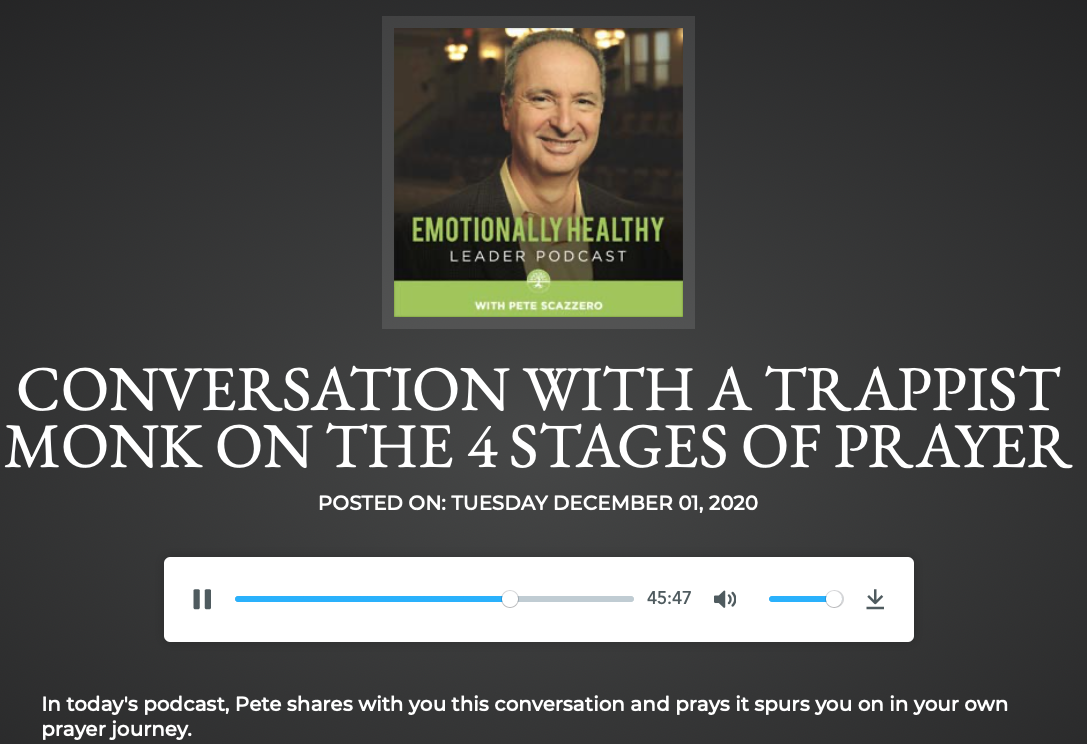Peter Scazzero – Mysticism, Roman Catholicism & Monasticism
Peter Scazzero, author of Emotionally Health Spirituality (EHS) and former lead pastor at New Life Community Church is leading many Christians down a road into CONTEMPLATIVE MYSTICISM (as outlined in part 2).
The source of this path is his transformative experience from visiting a monastery in 2003 and living with monks, and engaging in monastic practices during his stay there and on numerous occasions each year since then. He states that he would stay sometimes from a few days up to a week with the majority of time spent in silence, participating in monastic practices of “the Office” and learning from discussions with the monks at the monastery.

Now, he shares with many Christians through his books and speaking engagement. He is also now bringing monks to his church to teach his congregants how to engage in contemplative prayer, centering prayer, silence, stillness…etc. The monks are also going to be involved in teaching these practices to the children in the church.
Marcia Montenegro explains what these contemplative practices are and how they are tied in with Roman Catholic monks:
CONTEMPLATING CONTEMPLATIVE PRAYER: IS IT REALLY PRAYER?
….Contemplative Prayer, also called Centering Prayer or Listening Prayer, has been taught by Roman Catholic monks Thomas Merton, Thomas Keating, and Basil Pennington, as well as by Quaker Richard Foster, and is being advocated by many others. There is no one authority on this method, nor is there necessarily a consistent teaching on it, though most of the founding teachers quote medieval mystics, Hindu, and Buddhist spiritual teachers.
According to http://www.contemplativeoutreach.org, “Centering Prayer is drawn from ancient prayer practices of the Christian contemplative heritage, notably the Fathers and Mothers of the Desert, Lectio Divina, (praying the scriptures), The Cloud of Unknowing, St. John of the Cross and St. Teresa of Avila. It was distilled into a simple method of prayer in the 1970’s by three Trappist monks, Fr. William Meninger, Fr. Basil Pennington and Abbot Thomas Keating at the Trappist Abbey, St. Joseph’s Abbey in Spencer, Massachusetts.” It should be added, “During the twenty years (1961-1981) when Keating was abbot, St. Joseph’s held dialogues with Buddhist and Hindu representatives, and a Zen master gave a week-long retreat to the monks. A former Trappist monk who had become a Transcendental Meditation teacher also gave a session to the monks.” 5
The influence of Buddhism and Hinduism on Contemplative Prayer (hereafter referred to as CP) is apparent. Words such as “detachment,” “transformation,” “emptiness,” “enlightenment” and “awakening” swim in and out of the waters of these books. The use of such terms certainly mandates a closer inspection of what is being taught, despite the fact that contemplative prayer is presented as Christian practice.
Themes that one finds echoed in the CP movement include the notions that true prayer is: silent, beyond words, beyond thought, does away with the “false self,” triggers transformation of consciousness, and is an awakening. Suggested techniques often include breathing exercises, visualization, repetition of a word or phrase, and detachment from thinking.
http://www.christiananswersforthenewage.org/Articles_ContemplativePrayer1.html
Peter Scazzero stated that his experience at the monastery in 2003 “altered” his life. With discussions with monks and his participation on retreats at the monastery, he learned contemplative prayer, silence, stillness…etc. Now, he is spreading his dabbling in Roman Catholicism and monasticism to many Christians both in his church and those who read his books. My church is currently holding a Growth Group class using Scazzero’s book – EHS. There are many things that are concerning about this.
After understanding the contemplative mysticism involved in Scazzero’s teachings, the next question that needs to be asked – why is a former C&MA pastor who is currently a pastor of a protestant Evangelical church learning from monks, engaging in monasticism and therefore passing along basic tenants of Roman Catholicism (RC) to the church? Let’s briefly reflect on the implications of this.
Out of ignorance or indifference, there has been increasingly a larger number of people who joint two very different theologies together – RC and Protestantism. To many, RC is just another denomination. The Emerging Church movement was/is far more ecumenical especially with younger Christians. Some will even state that there is no reason that RC and Protestant churches can’t come together on spiritual issues.
Heaven will be filled with believers who have placed their faith in Jesus Christ for their salvation – something that is not earned but totally paid for by Jesus Christ. These will be people who come from many different churches and denominations including both Protestant and Roman Catholic churches. However, the Bible states that salvation is by grace through faith – not through works. We are saved for good works but not saved by our good works (Ephesians 2:8-9). Roman Catholic believers who are truly saved will be saved because of this foundation and in spite of RC theology. RC doctrine includes works as an added condition to faith.
These differences are not minor. They are major differences that could place someone’s coming to salvation in jeopardy if they think they are good enough to earn their salvation. Protestant Reformers focused on five “solas” (“only” in English) that defined their distinctions. These include Sola scripture (Scripture alone), Sola fide (faith alone), Sola gratia (grace alone), Solo Christo (Christ alone), and Soli Deo Gloria (to the glory of God alone).
These five themes primarily center on two key distinctions.
(1) JUSTIFICATION: First, Protestants believe salvation is by grace alone through faith alone in Christ alone.
Ephesians 2:8-9 states “For it is by grace you have been saved, through faith—and this is not from yourselves, it is the gift of God—not by works, so that no one can boast.”
This is in contrast to Roman Catholic beliefs which include salvation by faith in Jesus in addition to a variety of works of grace. How one comes to faith based on what criteria is a critical part of one’s faith. This is not a minor issue by any means and is a distinct difference between RC and Protestantism.
(2) AUTHORITY: Second, Protestants belief in the Bible as the sole authority on matters of faith. Roman Catholic teaching believe that the Pope as well as the role of Sacred Tradition – both areas include additional revelation that is authoritative. (Note: The Orthodox Church excludes the authority of the Pope but accepts the authority of Sacred Tradition.)
(3) Other differences: With these two fundamental differences, Roman Catholic teachings include several other teachings that don’t originate from Scripture but are passed down from church tradition. It is important to realize that there are several different teachings between the Catholic and the Protestant faith. Praying to a sinless Mary, celebrating the Mass, venerating the Pope, salvation comes through the Church — the Roman Catholic Church……you won’t find those doctrines in the Bible. Yet, Evangelicals are being seduced into accepting these doctrines as they are exposed to teaching from Protestant leaders who write, teach, and put into practice these traditions in their own church.
=> While Roman Catholic theology has a number of doctrines in common with Protestant theology (Trinity, the deity of Christ, etc.), there are many deviations from orthodox theology. A foundational difference is the Roman Catholic authority of tradition in addition to the authority of the Bible. In effect, tradition in a sense supersedes the authority of the Bible because tradition and church councils make decrees that countermand and/or add to the explicit teachings of Scripture. This opens up the church to the doctrine that varies widely from Scripture. Numerous differences have developed over time and will continue to grow as new Popes and church leadership continues to change. This is far from a minor difference between denominations and should be taken seriously when Evangelicals decide to partner up with the Roman Catholic Church on spiritual issues.
=> Peter Scazzero, in his latest podcast, just had a Roman Catholic monk, Fr. William Meninger, give a series of teachings and sermons to the congregation. The monk taught them what Contemplative Prayer is. Scazzero promoted the podcast as follows –
As church leaders, it is critical we develop the practice of learning from other streams other than our own. Years ago, I sat down with Trappist Monk, Fr. William Meninger, to receive a fresh perspective about a life of prayer.
During this interview, he references how the journey of prayer comes in four stages. Each stage is beautiful and important for growing in communion with God.
But, more than ever, it is critical we learn how to develop our ability to be with Jesus in the fourth stage – contemplative prayer.
In today’s episode, I share with you this conversation and pray it spurs you on in your own prayer journey.
Meninger
Scazzero describes this “conversation” with a Trappist monk as “critical” to learn, a “fresh perspective” about prayer, “growing in communion with God”, “to be with Jesus…..in contemplative prayer”….etc. This points people on the path of engaging in mysticism. In Part 2 of this blog, we noted that much of this is a subtle redirection couched in the religious-sounding description that for some doesn’t raise any red flags. But the specifics of what is being taught is mysticism. It has less in common with the Bible and more in common with early Roman Catholic mysticism as well as Eastern religions and Eastern Mysticism. The New Age tends to mimic many practices found in Eastern Mysticism, so there are similarities there also.
A believer in Christ has to ask themselves – why would I participate in these practices with little basis in the Bible and more commonality with other religions?


Thank you for your thoughts on this book. Our church ladies are beginning the study of this book next month. I have tremendous misgivings and have decided not to attend. My basic observation is that this teaching is only for those who live in a very small mindset. What about the intellectually naive or handicapped – the physically disabled – the poor who work several jobs to provide for their families – anyone in a ‘third world’ country who doesn’t know where their next mouthful of food will come from – my autistic non-verbal 12 year old granddaughter who knows Jesus in a much deeper and more beautiful way than I ever will yet she cannot read nor comprehend what this book is about.
This is my point – if the people on the autistic spectrum, the Down syndrome, the mentally ill, those catastrophic head trauma sufferers, etc. cannot hope to understand or put themselves into the ‘prayer positions’ or time their prayer times with the Lord in any way, then this book only carries with it bondage, fear and failure.